5 Jyotirlinga in Maharashtra Travel Guide: Everything You need to know!
India is a land of mysteries. A rich cultural backdrop, an equally magnificent heritage, and a journey of faith run through the very veins of this incredible land. People from different religious beliefs and diverse cultures live and work under the same roof here. India is particularly known for its incredible temples spanning the entire country. Today, we will discuss one of the prominent sets of Shaivaite temples called “Jyotirlingas” in India, or more specifically, in Maharashtra. If you have plans to visit the Jyotirling in Maharashtra shortly, this article will assist you in the best possible manner. We have gathered all the information, from the entire list of Jyotirlingas in Maharashtra and the location and timings of the temples to the 5 Jyotirlingas in Maharashtra map to guide you throughout the journey. So, let us get started already! In case you want to know about all the 12 Jyotirlingas. You can have a look at 12 Jyotirlingas in India article here – 12 Jyotirlingas in India
Table of contents
What is a Jyotirlinga?
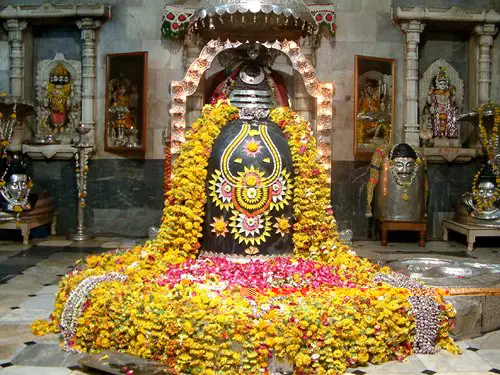
According to Hindu religious belief, the universe is created, sustained, and destroyed by the trinity Gods: Lord Brahma, Lord Vishnu, and Lord Shiva. All three Gods have equal significance in their respective jobs. However, it is an interesting fact that Lord Brahma is not worshipped by anyone in any temple.
There is a story behind this. One day, Brahma and Vishnu got into a fight regarding who is more important to the universe. Shiva became the mediator and turned into an infinite pillar of light. The contest was to find the end of the pillar. While Brahma summoned his vehicle, the swan, and flew upwards, Vishnu took the form of Varaha, one of his manifestations, and went downwards. None of the two Gods could reach the end.
Before going long, Vishnu realized the greatness of Shiva and accepted defeat. Brahma, on the other hand, lied that he found the end of the pillar. A furious Shiva cursed that owing to his dishonesty, no one will ever worship Brahma.
Subsequently, while Shiva returned to his original form, the infinite pillar of light disintegrated into several fiery columns of light and scattered at different locations on Earth. These locations are called Jyotirling. Although it is said that there are 64 such locations, 12 of them are considered to be of supreme significance. In further discussion, we’ll talk about the 5 Jyotirlingas in Maharashtra.
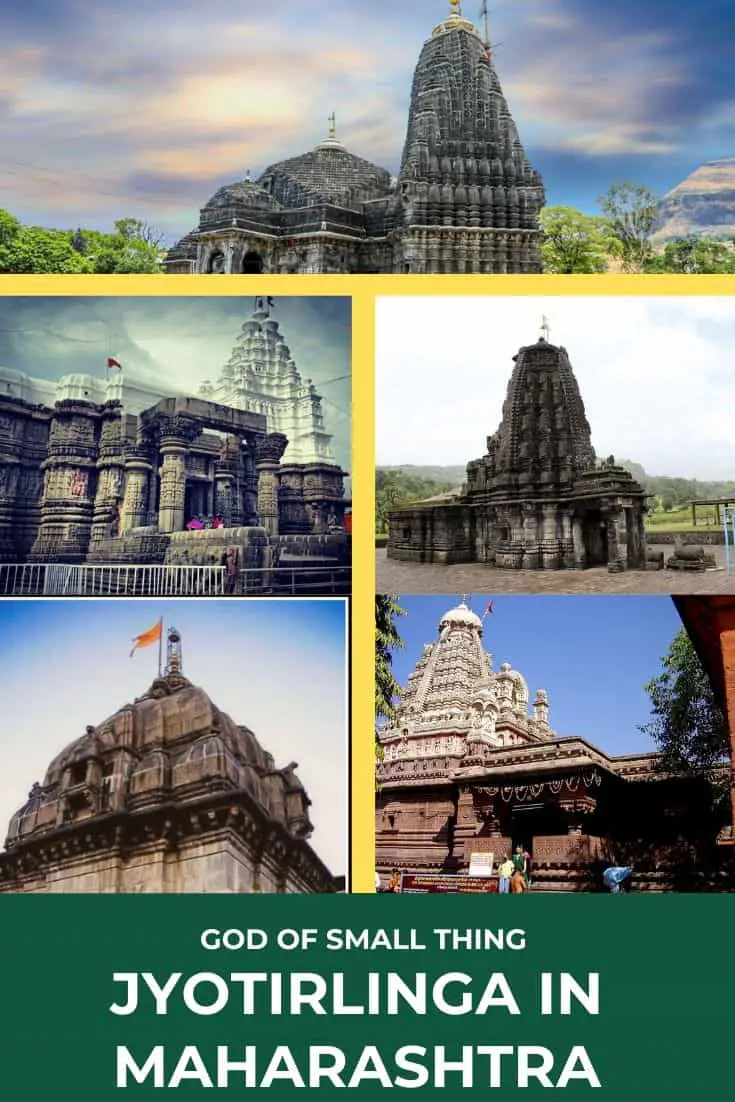
Jyotirlingas in Maharashtra
Here is the list of 5 Jyotirlingas in Maharashtra:
1. Bhimashankar Jyotirlinga

Bhimashankar temple is a picturesque temple located in Pune. It is the first temple in the list of Jyotirlingas in Maharashtra. The deity of the temple is of the Shivling form i.e. the pillar form of Lord Shiva which symbolizes the infinite mighty nature of God.
The Shivling here is the Swayambhu Lingam which means the Shivling self-emanated from the earth’s surface. The Shivling is at the exact centre of the Garbhagriha. The temple is a major pilgrimage site in Maharashtra. However, apart from the huge number of devotees and pilgrims, this place also attracts a lot of passionate trekkers and nature lovers.
With a ravishing background presented by the Sahyadri ranges, this temple is your go-to location if you want a blend of spirituality and adventure. Bhimashankar is also the place of origin of the river Bhima, which is a tributary of the river Krishna. Additionally, the Bhimashankar Wildlife Sanctuary nearby houses an abundance of flora and fauna.
Looking to enjoy culture in India? Here is a list of best and most famous festivals in India: Famous Festivals in India
Bhimashankar Jyotirlinga Story:
Once upon a time, there were three demon brothers: Tarakaksha, Kamalaksha, and Vidyunmali. They did penance for thousands of years to please Brahma. When Brahma appeared in front of them, they asked for an unusual boon. They said that three majestic cities be made.
They should be each of gold, silver, and iron, to be placed in heaven, sky, and earth respectively. Once in a thousand years, these three cities should come in a single line, called “Tripura“, meaning three cities. Now, if there were a person who could use a single arrow to destroy all three cities in one go, only that person should be able to kill them. The demons were sure no one could do this. This is because the three cities aligned only for one second in a thousand years. And to destroy these magnificent cities in one go, using just one arrow was impossible.
The brothers thought they had become immortal and started creating havoc in the world. The demigods consulted Lord Shiva for saving the world. He promised that he would destroy them. For this, Vishwakarma, the architect of the Gods created an arrow called Pashupataastra.
When the three cities aligned, Lord Shiva used his might to summon the Pashupataastra and his undeterred aim destroyed all three cities in a single stroke. This is why Shiva is called “Tripurantaka” meaning the destroyer of Tripura. Later, he killed the brothers to revive peace in the world. It is believed that after the battle, a tired Shiva sat down on a mountain. This is where the Bhimashankar temple is situated now. According to legend, the sweat that poured from the Lord’s body became the Bhimarathi river or river Bhima.
Bhimashankar Temple Architecture:
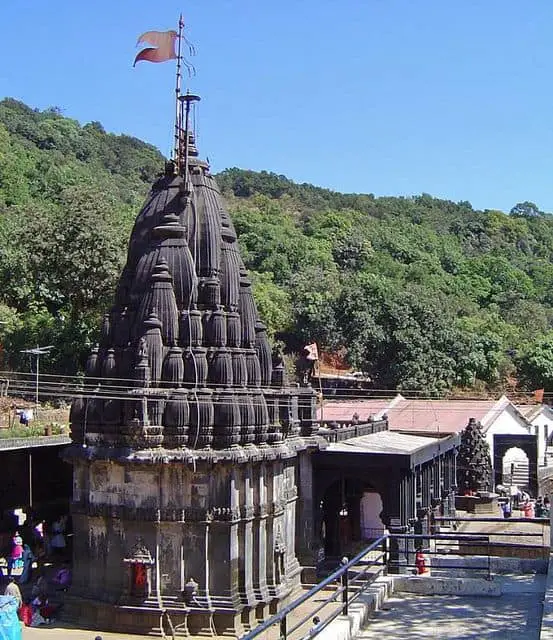
The temple is built in the ancient Nagara style of architecture. The temple is first believed to have been constructed by Vishwakarma himself. Nana Phadnavis was a prominent figure in the Maratha administration during the 18th century. He is said to have made major developments in the temple.
It was he who established the towers and the sabha mandapa inside the temple. The sanctum inside the temple where the Shivling is situated is on a lower level of the ground as compared to other Jyotirling in Maharashtra. There is a unique bell in the temple which has an idol of Mother Mary on it. It is said that Chimaji Appa, a military commander of the Maratha dynasty, defeated the Portuguese at the Vasai fort and brought back five such bells. One of the bells was adorned at the Bhimashankar temple.
There is a shrine dedicated to Lord Shanidev inside the temple. Additionally, there is an idol of Nandi, the vehicle of Shiva, standing guard at the entrance of the temple. There are beautiful carvings from stories of Hindu mythology on the walls inside the temple. Records of the temple date back to the 13th century as there is proof that Saint Jyaneshwar who lived during this time had visited the temple. It is said that Chhatrapati Shivaji Maharaj, the greatest Maratha ruler of all time, had made significant improvements in the temple to facilitate the pilgrims.
Bhimashankar Temple Location: Bhimashankar temple is located in the Ghat region of the Sahyadri ranges. The exact location is about 50 km from Khed. It is in the Pune district of Maharashtra. The address of the temple is
Shivtritha, Shree Kshetra, Bhimashankar, Maharashtra 410509.
How to reach Bhimashankar Jyotirlinga
By road: The nearest cities are Pune and Mumbai, which are at a distance of 111 kilometres and 197 kilometres respectively. If you’re travelling from Pune, the best option is by catching an MSRTC bus. These buses ply from Pune to Bhimashankar every 30 minutes between 5.30 am and 4 pm. Another option is a State Transport bus from Shivajinagar, Pune. If you’re travelling by your own vehicle, you have to take the Pune-Nashik highway and turn on the road leading to Bhimashankar.
It takes about 3-5 hours to reach Bhimashankar from Pune, by road.
If you’re travelling from Mumbai, the best way is to travel by State transport buses that start from Mumbai Central, Parel, Kurla Nehrunagar, and Kalyan. You can get down at Ghodegaon or Manchar and from there, it is easier to reach because of plenty of frequent buses plying to Bhimashankar. If you choose to travel by private vehicle, you have to take the Mumbai-Pune highway and turn left at Wadgoan on the State Highway. After going about 12 kilometres, you will reach Chakan. From here, drive through NH-50 to reach Manchar. You will reach Bhimashankar by going straight for about 65 kilometres on this route.
It takes about 6-8 hours to reach Bhimashankar from Mumbai, by road.
By air: The nearest airport is Pune international airport. It is at a distance of 106 kilometres from the temple. It will take you about 2-3 hours to reach the temple from the airport. If you have alighted at Mumbai international airport, you’re at a distance of 204 kilometres from the temple. It will fairly take you 5-7 hours to reach the temple.
By rail: Pune junction is at a distance of 108 kilometres from Bhimashankar temple. This is the nearest railway station. You can catch a cab or taxi from the station and reach the temple in about 3-4 hours.
Bhimashankar Jyotirlinga Timings:
| Timing | Pooja/ Aarti |
| 4.30 am | Kakada Aarti |
| 5 am | Nijarup darshan |
| 5.30 am | Regular pooja, Abhishek starts |
| 12 noon | Naivedya pooja (No Abhishek) |
| 12.30 pm | Regular pooja, Abhishek starts |
| 3 pm | Madhyan aarti (No darshan for 45 minutes) |
| 4 pm to 9.30 pm | Shringar darshan ( No Abhishek) |
| 7.30 pm | Aarti |
| 9.30 pm | Temple closes |
2. Trimbakeshwar Jyotirlinga
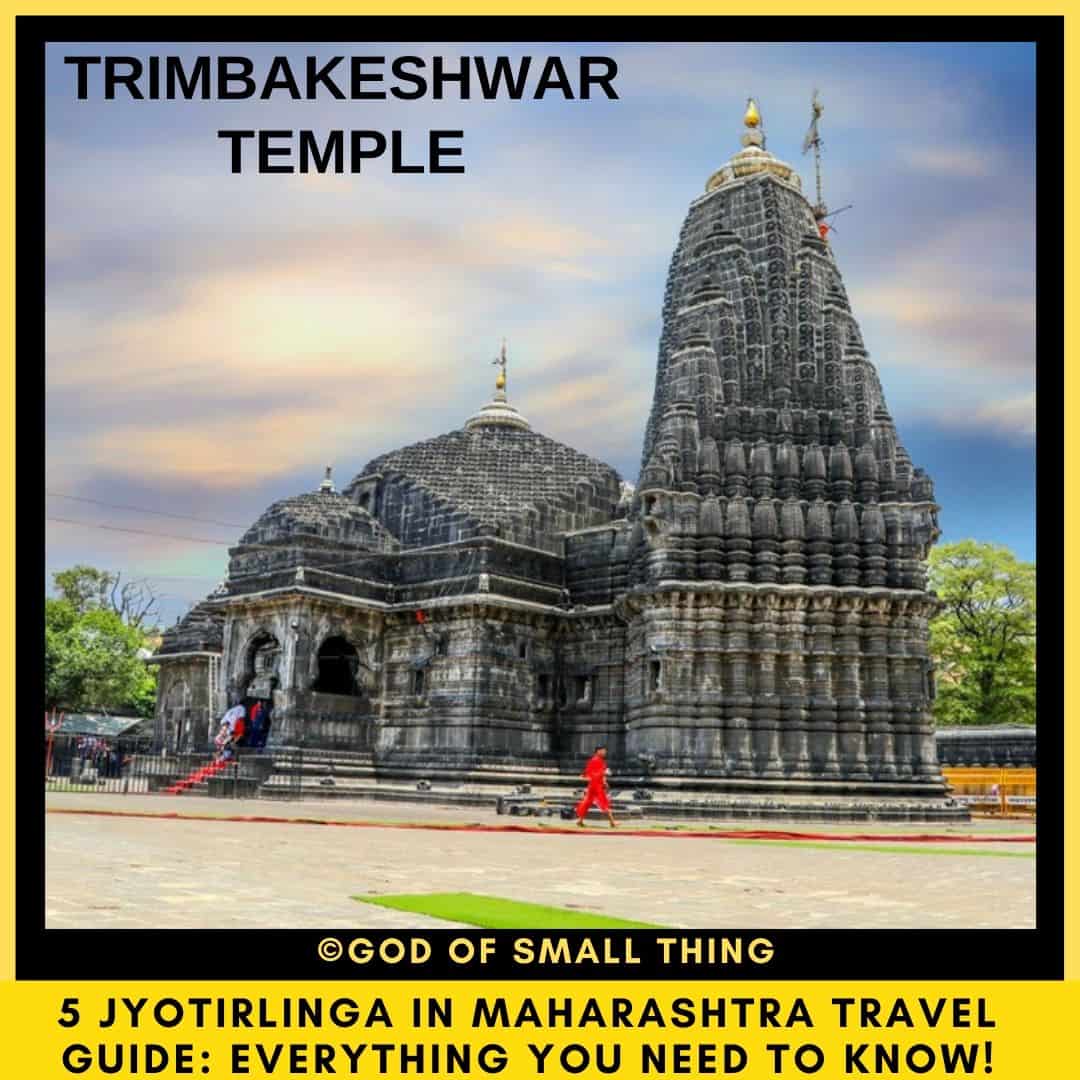
Trimbakeshwar temple is one of the twelve Jyotirling temples in India and an important temple in the list of Jyotirlingas in Maharashtra. The temple is situated in the Trimbak town of Nashik. There are three hills, namely, Brahmagiri, Nilagiri, and Katagiri surrounding this magnificent temple. The main deity is the Shivling.
The deity of this Jyotirlinga temple is unique because there are three faces or three lingams for the deity. It is said to resemble the trinity Gods: Brahma, Vishnu, and Shiva. Apart from the main deity, there are additional shrines for Gangadevi, Rameswara, Jaleswara, Gautameswara, Kedarnath, Krishna, Rama, Parasurama, and Lakshmi Narayana. The area surrounding the temple is a feast for the eyes of nature lovers. Trimbakeshwar is also the origin point of the river Godavari, the longest river in India.
Trimbakeshwar Temple Story:
Gautama was a Maharishi who served others and performed his prayers and penance regularly. As a result, his fame and prosperity rose to the heavens. Indra, the king of demigods feared that Gautama would become more prosperous than him. To stop this, Indra made Gautama accidentally commit a sin. Although it happened unintentionally, Gautama was deemed sinful.
To wash away his sins, he was advised to bathe in the holy river Ganga. At that time, Ganga didn’t flow on earth. Since Goddess Ganga was a consort of Lord Shiva, she permanently stayed inside his jata or hair locks. So, Gautama performed penance to please Shiva. When Shiva appeared, he requested that Ganga flow through the earth’s surface so that he could take a dip in the river and wash away his sins. Shiva knew that Gautama has accidentally committed the sin, and pleased by his devotion granted his wish.
However, an adamant Ganga was not ready to go to earth. Seeing this, Shiva became angry and performed the Tandav. Ganga was terrified to see Shiva’s rage. She did flow down from Shiva’s jata, but decided to take revenge on Gautama for turning her husband against her. She appeared at Brahmagiri near Gautama’s ashram.
When Gautama approached Ganga, she disappeared before he could reach there. She kept on doing these at multiple points which later came to be known as Trimbak Tirtha, Gangadwar, Varaha Tirtha, Rama Laxman Tirtha, and Ganga Sagar tirtha. At last, when Ganga appeared, Gautama aimed her with a handful of enchanted grass and placed a vow on her. The river couldn’t move any further from there. Gautama then took a dip in the river and emerged free from sin. This place is called Kushavarta and is the source of the Godavari river. Kushavarta is located inside the Trimbakeshwar temple.
Trimbakeshwar Temple architecture:
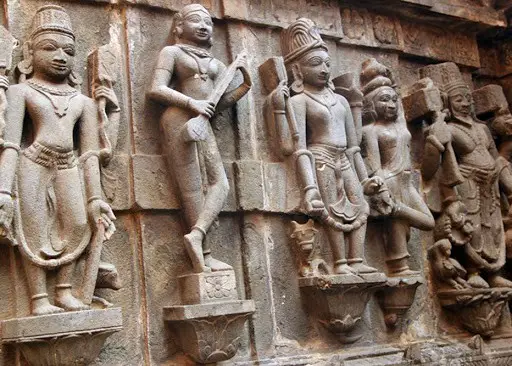
The temple is one of the grandest Shiva temples in India in the context of architectural brilliance. It is entirely built on a black stone in the Hemadpanti style. The temple was constructed by Peshwa Balaji Baji Rao. The Kushavarta Kund, the source of Godavari, was constructed by Shrimant Sardar Raosaheb Parnerkar, the then Fadnavis of Indore.
There is a bust dedicated to Sardar and his wife here. The lingams in the temple are masked by a charming, heavily-decorated crown that has diamonds, emeralds, and other priceless stones. This crown is said to date back to the time of the Pandavas. Every Monday, the crown is displayed in the temple from 4 to 5 pm. The original deity of the temple was made of Nassau Diamond. This extremely precious and rare stone was stolen by the British during the Third Anglo-Maratha war. Trimbakeshwar temple is one of the few Jyotirlingas in Maharashtra that houses Samadhis of many famous saints and various ashrams.
Trimbakeshwar Temple Location: The Trimbakeshwar temple is located in a town called Trimbak in the Nashik district of Maharashtra. It is about 30 kilometres away from the main city of Nashik. The exact location of the temple is as follows: Shrimant Peshwe Path, Trimbak, Maharashtra 422212
How to reach Trimbakeshwar Jyotirlinga:
By road: The nearest city is Nashik which is about 30 kilometres away from the temple. One can avail of taxis or MSRTC buses from Nashik to Trimbakeshwar. It will take less than an hour to reach the temple from Nashik. If you’re travelling from Mumbai, in a private vehicle, you should take the NH-3 route. Also, private buses and taxis are plying to Trimbakeshwar from Mumbai. Mumbai is around 180 kilometres away from the temple. So, it will take you at least 3-4 hours to reach the temple from the city.
By air: If you’re coming by flight, Nashik airport is the nearest to the temple. It is at a distance of 50 kilometres from Trimbakeshwar. You can also choose to alight at the Mumbai international airport which is about 178 kilometres away. Taxi or cabs will take you from the airport to the temple.
By rail: Nashik railway station, located about 36 kilometres from the temple is the nearest option. Frequent trains run from other parts of the country to Nashik. So, if you choose to reach by train, your journey would be convenient enough.
Trimbakeshwar Jyotirlinga Timings:
| Darshan timings | 5.30 am to 9 pm |
| Rudrabhishek | 7 am to 8.30 am |
| Afternoon pooja | 1 pm to 1.30 pm |
| Shiva Golden crown darshan | 4.30 pm to 5 pm |
Love travelling to spiritual places? Here’s one personal recommendation for you crafted to make sure you don’t have any problems while traveling: Travel to the spiritual capital of India – Varanasi (Banaras)
3. Grishneshwar Jyotirlinga

Grishneshwar is the last of the twelve Jyotirlinga temples in India. It is situated in Verul in Aurangabad. “Grishneshwar” translates to Lord of compassion. This temple underwent several renovations after it was mostly demolished during the Sultanate’s rule in the 14th century. The main deity is the Shivling which faces towards the east.
There is a statue of Nandi, the vehicle of Lord Shiva in the court hall of the temple. Grishneshwar temple is also credited as the smallest Jyotirlinga temple in the list of Jyotirlingas in Maharashtra. Most tourists who visit the famous UNESCO site, Ellora Caves, make sure to visit this temple. This is because the temple is located only a couple of kilometres away from Ellora caves. So, Grishneshwar temple is also one of the popular temples in the list of Jyotirlingas in Maharashtra.
Grishneshwar Jyotirlinga Story:
According to Shiv Puran, there once lived a couple called Brahmavetta Sudharm and Sudha in Devagiri. The couple were devotees of Lord Shiva and prayed for a child. But, in spite of everything, they didn’t get blessed with a child. Desperate to have a baby, Sudha insisted her sister Ghushma marry her husband.
Ghushma was also an ardent devotee of Shiva. She made 101 Shivlings daily and discharged them in the nearby lake as an offering, by Sudeha’s advice. Soon, she bore a son. Although Sudha should have been happy to finally have a baby, she became jealous of her sister. As time passed, Sudha grew monstrous and one night, killed Ghushma’s son in cold blood.
Despite learning about this, Ghushma remained unaffected. Such was her devotion to Shiva, that she said, “He who has given me this child, shall protect him”. Ghushma made 101 Shivlings that morning too and immersed them in the lake as usual.
Upon this, her son emerged alive from the lake. But, she wasn’t overjoyed upon seeing him either. She kept chanting the Lord’s name without being affected by anything. Shiva was pleased with her devotion and appeared in front of her. When she was told to ask for a boon, she prayed that the Lord stay at that place and bless everyone. That is how the Lord became Ghushmeshwar, which later became Grishneshwar by word of mouth.
Grishneshwar Temple architecture:

The temple underwent severe demolition in the 14th century under the rule of the Delhi Sultanate. It was rebuilt and renovated many times after this. The first attempt at the renovation was by Maloji Bhosale of Verul, who is also the grandfather of Chhatrapati Shivaji Maharaj in the 16th century. Ahilyabai Holkar, the then Queen of Indore, constructed and renovated the temple in its current form in the 18th century.
The Queen is also known for renovating other famous temples like Kashi Vishwanath temple and Somnath temple. The temple architecture is in South Indian Hemadpanti style. The temple is one of the few Jyotirlingas in Maharashtra to be built on red rock. The court hall has 24 majestic pillars. Throughout the temple and on these pillars, eye-catching carvings and paintings of various characters from Hindu mythological texts have been made. One of the most attractive carvings is the Dasavathara of Lord Vishnu.
Grishneshwar Jyotirlinga Location: Grishneshwar temple is located in Verul, in the proximity of the world-famous Ellora caves in Aurangabad. It is about 30 kilometres away from the main city of Aurangabad. The following is the address of the temple: NH 211, Verul, Maharashtra 431102
How to reach Grishneshwar Jyotirlinga:
By road: Grishneshwar temple is about a distance of 30 kilometres from Aurangabad. You can easily avail of buses or taxis to reach the temple. If you’re on a trip to Ellora caves, you must not miss visiting this temple which is only a couple of kilometres away from the caves. The metro city of Mumbai is about 342 kilometres away from Grishneshwar temple. If you’re travelling from Mumbai, it will take you about 8-9 hours to reach the place.
By air: The nearest airport is Aurangabad Airport, which is at a distance of 36 kilometres from Grishneshwar temple.
By rail: If you opt to travel by train, you can reach out conveniently by getting down at Aurangabad station. The temple is about 29 kilometres away from the station.
Grishneshwar Jyotirlinga Timings:
| Darshan timings | 5.30 am to 9.30 pm |
| Darshan timings during Shravan month | 3 am to 11 pm |
| Afternoon pooja | 1 pm to 1.30 pm |
| Evening pooja | 4.30 pm to 5.30 pm |
4. Aundha Nagnath temple Jyotirlinga
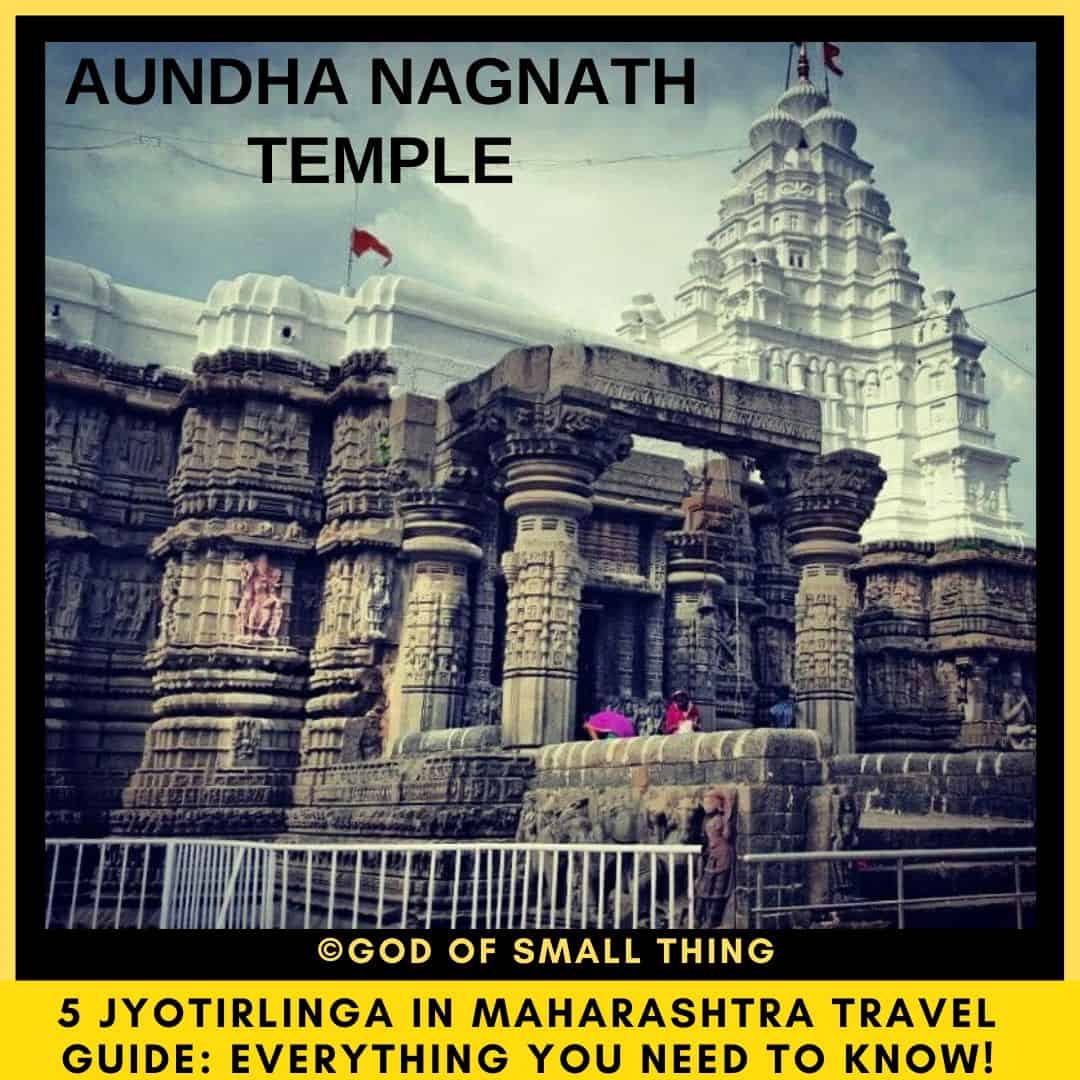
Aundha Nagnath temple is one of the lesser-known temples in the list of Jyotirlinga temples in India. It is located at the Aundha Nagnath town in Hingoli district of Maharashtra. The temple is believed to have been built by Yudhishtir, the eldest Pandava brother, while they were in exile for 14 years. Records state that this Jyotirlinga temple in Maharashtra dates back to at least the 13th century and was constructed by the Yadava dynasty. The temple attracts tourists for its majesty and religious significance. Additionally, a reserve forest region surrounds the temple which adds to its beauty. It ranks fourth in our list of Jyotirlinga in Maharashtra.
Aundha Nagnath Temple Story:
The temple is believed to be the first Jyotirlinga to have appeared on earth. Aundha Nagnath temple is closely associated with the lives of great saints like Sant Namdev, Visoba Khechara, and Sant Jyaneshwar of the Varkari sect of Hinduism. It is said that Sant Jyaneshwar advised Namdev, to go to Aundha Nagnath temple when he was in search of a teacher.
When Namdev reached Aundha Nagnath temple, he saw Visoba Khechara sitting with his feet on the Shivling. Namdev was agitated and accused Visoba of insulting God. Hearing this, Visoba smiled and asked Namdev to place his feet anywhere where there was no Shivling. When Namdev placed his feet on the ground, a Shivling appeared there. When he put his feet in another place, another Shivling appeared. Soon, the area was full of Shivling. Namdev realized that Visoba was teaching him that God is omnipresent. He fell on his feet and accepted Visoba as his teacher.
In another instance, when Sant Namdev was singing bhajans in front of the shrine, the priest ordered him to go out and pray, as he was of a lower caste. So, Sant Namdev went to the backside of the temple and started singing bhajans. However, Lord Shiva couldn’t stay away from his devotee and the temple itself rotated so that Namdev was in front of the shrine. It is believed that this is why the statue of Nandi, Shiva’s vehicle is at the backside of the temple. This is the only Shiva temple to house such a peculiarity.
Aundha Nagnath Temple architecture:
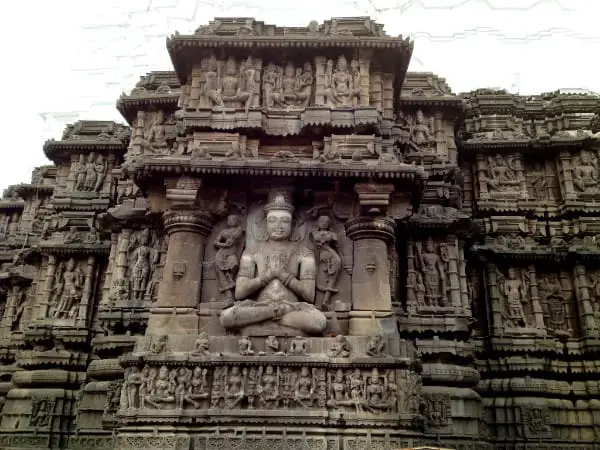
The temple is full of intricate carvings from various tales of Hindu mythology. The architecture used in building the temple is an ancient Hemadpanti style. The temple was initially built in a seven-storied form. However, this upper part was destroyed during the reign of Aurangzeb. Subsequently, the upper portion of the temple was renovated during the Peshwa regime and has a mixture of architectural styles from that period. The Garbhagriha in this temple is located below the ground level. There is a narrow chamber around the shrine where devotees can sit and chant prayers in peace.
Aundha Nagnath Location: The temple is situated in Aundha Nagnath in the Hingoli district of Maharashtra. The address of the temple is as follows:
Nanded – Aundha Rd, Aundha Nagnath, Maharashtra 431705
How to reach Aundha Nagnath temple Jyotirlinga:
By road: Parbhani and Nanded are the nearest cities to the temple. Parbhani is about 50 kilometres from the temple and Nanded is at a distance of 64 kilometres. There are roads connecting these cities to other major cities like Mumbai, Pune, and Aurangabad.
By air: The nearest airport to Aundha Nagnath temple is Nanded Airport. It is at a distance of 60 kilometres from the temple.
By rail: Parbhani junction is the nearest railway junction to Aundha Nagnath temple. The distance from the junction to the temple is 50 kilometres.
Aundha Nagnath temple Jyotirlinga Timings:
| Darshan timings | 4 am to 9 pm |
| Darshan timings during Shravan month | 4 am to 10 pm |
| Afternoon pooja | 1 pm to 1.30 pm |
| Evening pooja | 4.30 pm to 5.30 pm |
Which is the best time to visit Aundha Nagnath temple Jyotirlinga? : The ideal time to visit is in the early morning before dawn.
Is the Aundha Nagnath Temple open throughout the year? No, Aundha Nagnath (Nageshwaram) is a pilgrimage place in the district of Hingoli, Maharashtra, India. The existing temple is claimed to have been erected by the Sauna (Yadava) dynasty in the 13th century.
5. Parli Vaijnath Jyotirlinga
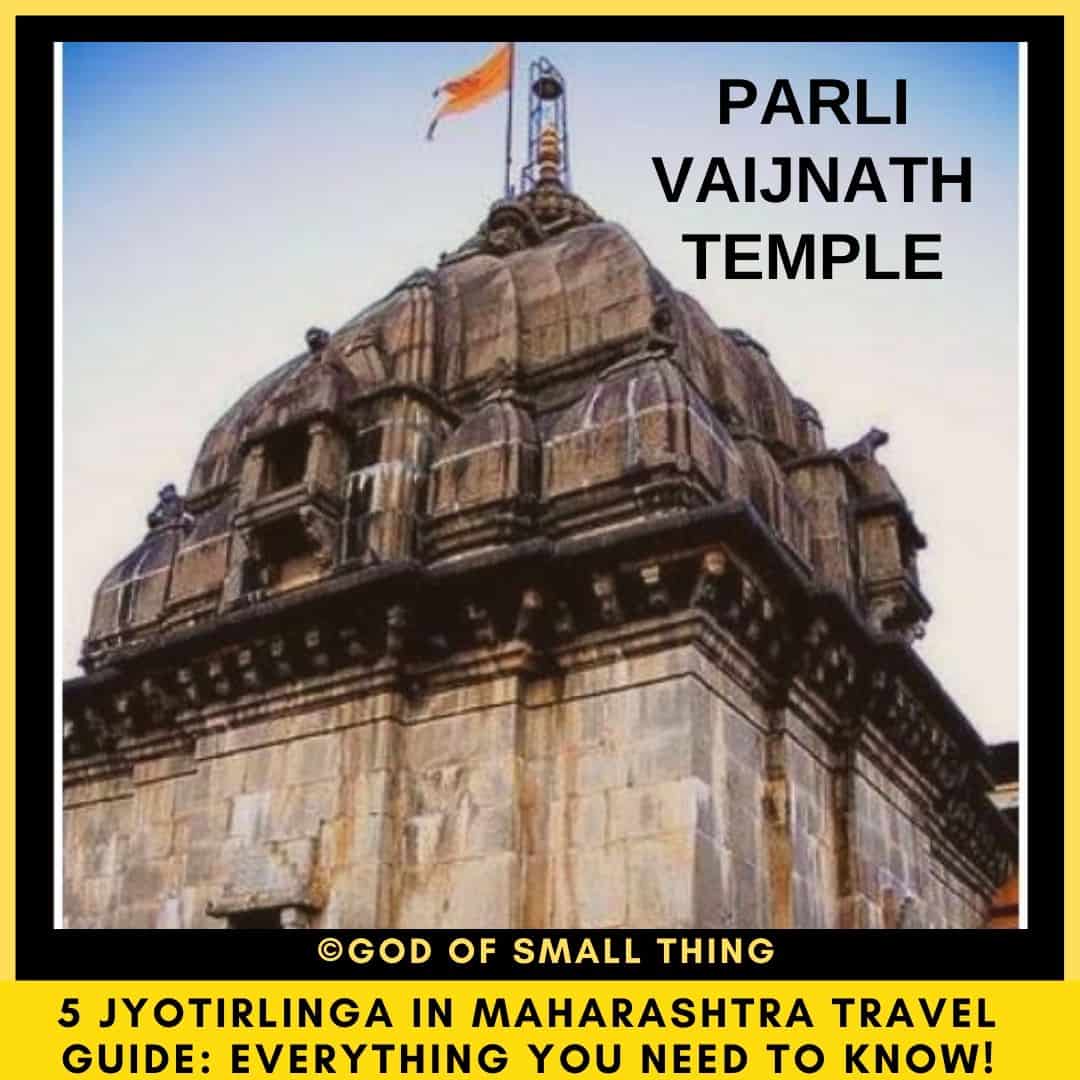
Parli Vaijnath temple is a renowned member of the list of Jyotirlinga temples in Maharashtra. The temple is situated in the Beed district. It is located on top of a hill. The main deity is the Shivling, like in all Jyotirlingas in Maharashtra.
The temple is also believed as the meeting point of Hari and Hara. Hari is another name of Lord Vishnu while Hara is for Lord Shiva. This is why festivals related to both Gods are celebrated with equal importance in this temple. Additionally, there is a tirtha or pond named Harihara Thirtha from where water is bought daily for the Abhishek ritual of Parli Vaijnath. The main deity of the temple is of the form of Vaidyanath which means the curer of all diseases, as the forests and hills surrounding the temple have an abundance of medicinal herbs.
Parli Vaijnath Jyotirlinga Story:
As per mythology, Ravan, the antagonist of the great epic Ramayan, was an ardent devotee of Lord Shiva. Ravan performed strict and painful penance for thousands of years to please Shiva. One day, when Shiva appeared in front of him, Ravan requested that the Lord take the form of a Shivling and accompany him to Lanka.
The demigods feared that if Shiva went to Lanka, Ravan will remain undefeated forever. So, to stop this, they sent an old boy on the path which Ravan was walking towards Lanka. Ravan had been carrying the Shivling in his arms, all the way. This was because, Shiva had put a condition Ravan has to carry the Shivling without placing it on the ground, even once. And that only then, will Shiva go to Lanka. It ranks 5th in our list of Jyotirlingas in Maharashtra.
When Ravan had travelled a long way and was getting tired, he saw the boy. So glad, he asked the boy to hold the Shivling for some time and went to a nearby lake. But, when the boy held the Shivling, the weight of the Shivling kept increasing every minute. At last, unable to hold it any longer, the boy kept it on the ground. The Shivling stuck there and remained there forever. It is said that this was because of Shiva’s desire to stay at this place as Lord Vaidyanath. This is where the Parli Vaijnath temple is situated now.
Parli Vaijnath Temple architecture:
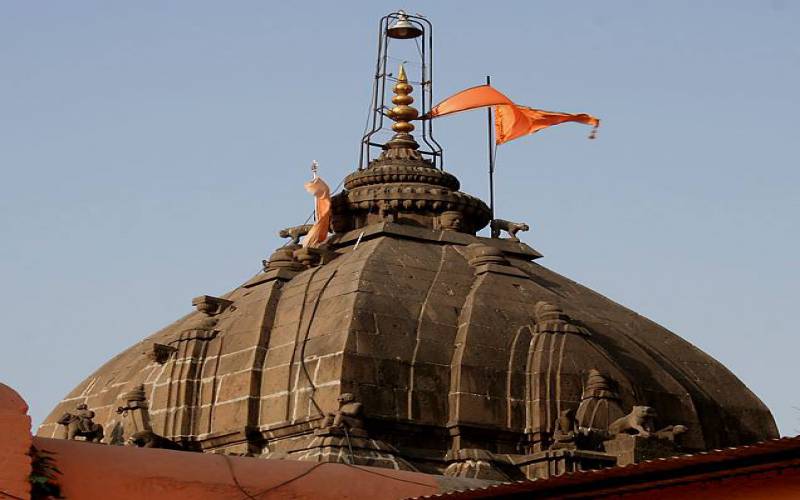
The Parli Vaijnath temple is built of stones on top of a hill. Hemandpanti style of architecture is used throughout the temple. The temple is about 80 feet high from ground level. An additional feature is that it is surrounded by thick, strong walls on all four sides.
There are intricate, exquisite carvings of stories from Hindu mythology on the walls of the temple. There is a huge brass-plated door at the main entrance on the eastern side called Mahadwar. The temple has many corridors and a huge courtyard inside. Besides, there is a minaret outside the hall that has windows or Gwakshas as it is called. It is said that when the first rays of sunlight reach the Shivling through these Gwakshas, the priests perform rituals for the Sun God.
The main hall of the temple is made of teak wood. Additionally, there are multiple ponds on the temple premises which have religious significance. The temple is believed to have faced demolition in the 14th century. Subsequently, it was renovated into its current form by Queen Ahilyabai Holkar of Indore in the 18th century.
Parli Vaijnath Temple Location: The temple is situated on top of a hill, in the Beed district of Maharashtra. The exact location of the temple is as follows: Pathanpura, Peth Mohallah, Parli, Maharashtra 431515
How to reach Parli Vaijnath Jyotirlinga:
By road: Parli is well-connected to major cities of Maharashtra like Mumbai, Pune, Aurangabad, and Nagpur. One can avail of buses or taxis from these cities to reach the temple. The nearest city, Parbhani is about 67 kilometers from the temple.
By air: The nearest airport from Parli Vaijnath temple is Latur Airport in Maharashtra. It is at a distance of 78 kilometres from the temple. It will take you about 2-3 hours to reach the temple from the airport.
By rail: Parli railway station is the nearest railway station. It is located about 2 kilometres from Parli Vaijnath temple.
Parli Vaijnath Jyotirlinga Timings:
The temple opens from 5 am to 3.30 pm, and 6 pm to 9 pm daily.
Special pooja timings are:
5 am: Shadopachar
6 pm: Shringar pooja
Apart from these, Somvaar pooja is held on Mondays.
5 Jyotirlingas in Maharashtra map:
If you plan to visit the five Jyotirlingas in Maharashtra, this Jyotirlinga map in Maharashtra can come in very handy to you.
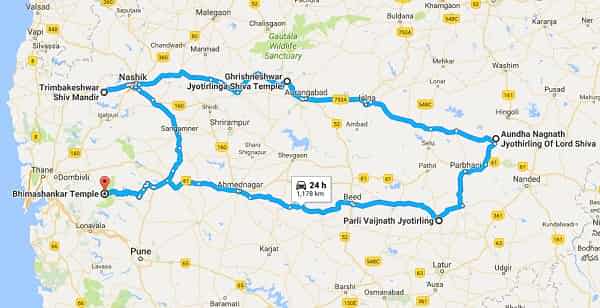
The 12 significant Jyotirlingas in India:
List of Jyotirlinga in Maharashtra: The following are the twelve Jyotirlinga temples in India:
- Somnath in Gir Somnath. State: Gujarat
- Mallikarjuna in Srisailam. State: Andhra Pradesh
- Mahakaleshwar in Ujjain. State: Madhya Pradesh
- Omkareshwar in Khandwa. State: Madhya Pradesh
- Kedarnath in Rudraprayag. State: Uttarakhand
- Bhimashankar in Pune. State: Maharashtra
- Vishwanath in Varanasi. State: Uttar Pradesh
- Trimbakeshwar in Nashik. State: Maharashtra
- Baidyanath in Deoghar. State: Jharkhand
- Nageshwara in Dwarka. State: Gujarat
- Ramanathaswamy in Rameswaram. State: Tamil Nadu
- Grishneshwar in Aurangabad. State: Maharashtra
We have provided you with the list of Jyotirlingas in Maharashtra with details and 5 Jyotirlingas on the Maharashtra map. We wish you a happy journey.
Looking to know in detail about all Jyotirlingas in India? Check out our Complete travel guide of 12 Jyotirlinga here
Some Frequently Asked Questions(FAQ)
How many Jyotirlingas are there in Maharashtra?
Five Jyotirlingas are in Maharashtra, Aundha Nagnath, Bhimashankar, Ghrishneshwar, Parali Vajinath, and Trimbakeshwar are Maharashtra’s five Jyotirlingas. Bhimashankar is a prominent pilgrimage site surrounded by deep forests.
Where are the 12 Jyotirlingas located?
Somnath in Gujarat, Mallikarjuna in Andhra Pradesh, Mahakaleswar in Madhya Pradesh, Omkareshwar in Madhya Pradesh, Kedarnath in Uttarakhand, Bhimashankar in Maharashtra, Viswanath in Uttar Pradesh, and Tryambakeshwar in Maharashtra, Grishneshwar, Maharashtra, Nageshvara, Gujarat, Ramanathaswamy, Tamil Nadu, Baidyanath, Jharkhand are the 12 Jyotirlingas.
How can I plan 5 jyotirlingas in Maharashtra?
- Day 1: Arrival in Mumbai.
- Day 2: Bhimashankar Temple in Mumbai.
- Day 3. Bhimashankar – Shirdi – Shani Shignpur – Aurangabad.
- Day 4: Aurangabad to Grishneshwar, then to Trimbakeshwar and Nashik.
- Day 5: Nasik to Trimbakeshwar, then to Mumbai.
Day 01: Mumbai to Shirdi
Embark on a captivating journey from the bustling streets of Mumbai to the serene sanctity of Shirdi. Consider the scenic route via Trimbakeshwar, an expedition that promises not just a destination but a symphony of experiences. Shirdi beckons and the path through Trymbakeshwar adds an extra layer of mystique to your adventure.
Day 02: Shirdi to Ahmednagar
As the pilgrimage unfolds, discover the treasures that lie between Shirdi and Ahmednagar. The Grishneshwar Temple in Ellora and the enigmatic Shani Shinganapur’s Temple are both jewels waiting to be unravelled. Each step is a revelation, each stops a story in the making.
Day 03: Ahmednagar to Mumbai
Bid farewell to Ahmednagar, but not before paying homage to the divine Bhimashankar. As you traverse back to Mumbai, let the echoes of your journey resonate with the seamless blend of perplexity and burstiness, leaving behind a trail of unpredictability that lingers in the minds of those who follow.

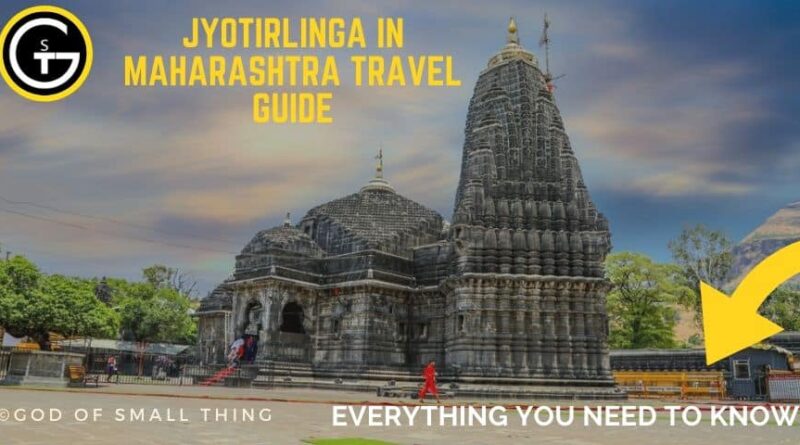



hey thanks for sharing this important information
Devotees visit these Jyotirlinga temples to seek the blessings of Lord Shiva and offer their prayers. These sacred sites hold immense spiritual and religious importance in the Hindu faith.
I want to express my sincere gratitude to Anjali Kesavan for her enlightening travel guide, “5 Jyotirlinga in Maharashtra Travel Guide: Everything You Need to Know!” This comprehensive article is a valuable resource for those planning to explore the spiritual and cultural richness of Maharashtra’s Jyotirlinga temples. Anjali’s meticulous research and informative content, including temple locations, timings, and maps, make it an indispensable guide for travelers seeking a profound religious experience. Thank you, Anjali, for sharing your insights and enhancing our understanding of these sacred sites.
Thanks for sharing about % 5 Jyotirlinga Travel Guide – Maharashtra . I am actually planning to explore these beautiful locations soon.